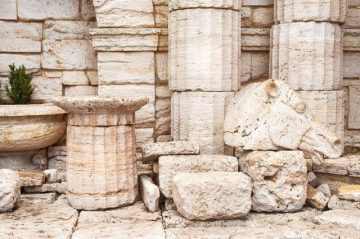FOR IMMEDIATE RELEASE

“Bioinspired Alkoxysilane Conservation Treatments for Building Materials Based on Amorphous Calcium Carbonate and Oxalate Nanoparticles”
ACS Applied Nano Materials
When it comes to cultural heritage sites, there are few things historians wouldn’t do to preserve them for future generations. In particular, stone buildings and sculptures made of plaster and marble are increasingly at risk of damage from air pollution, acid rain and other factors. Researchers now report in ACS Applied Nano Materials a new, calcium-based conservation treatment inspired by nature that overcomes many drawbacks of currently used methods.
Historically, conservation scientists have turned to alkoxysilanes, silicon-based molecules used to consolidate stone and other artworks, in their preservation efforts. However, alkoxysilane treatments do not bond properly with non-silicate surfaces, are prone to cracking and are limited in their ability to repel water. Adding other compounds to this treatment have helped overcome these effects, but only to a point. Instead Encarnación Ruiz Agudo and colleagues looked to nature for inspiration, and found that calcium could be the answer. As a major element of strong, natural structures like bone and kidney stones, the researchers theorized that nanoparticles made from calcium could bolster alkoxysilanes and provide the desired protective effects to conserve historical artifacts.
The researchers made calcium carbonate and calcium oxalate nanoparticles and included polydimethylsiloxane (PDMS) as a stabilizer. PDMS also likely helps the nanoparticles bond to surfaces. The team added the nanoparticles to traditional alkoxysilane treatments, then applied them to samples of three different building materials: white marble, calcarenite limestone and gypsum plaster, and put the samples through a battery of tests. Overall, the results showed enhanced hydrophobicity, less cracking and improved surface adhesion compared to alkoxysilane treatments alone, with calcium oxalate providing a marked improvement in acid resistance. A minimal color effect was observed, but the researchers say this change was within acceptable values for conservation efforts.
The authors acknowledge funding from the European Regional Development Fund, the Regional Government of Andalusia, the Spanish Ministry of Economy and Finance and the University of Granada.
Note: ACS does not conduct research, but publishes and publicizes peer-reviewed scientific studies.




